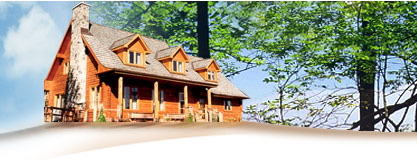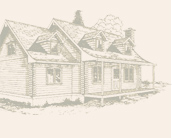 |
 |

| TECHNICALS DETAILS |
DRYING OF THE LOGSAt LAURENTIEN Log Homes, the pine is partially air dried at our factory and processed and installed with 30% to 35% humidity throughout. It will still require 3 to 5 years to stabilize at the humidity level of the building area. We dry the wood just long enough to be able to put a nice finish on it. The major drying process must take place after the wood is locked into place in the wall, with the tons of weight and pressure locking it into place. Our system was developed to take advantage of wood moisture and our log wall structures will increase in strength and tightness as they dry. However, at LAURENTIEN Log Homes, we can supply all of the following possibilities: Green, Air dried, Kild dried. TO DRY OR NOT TO DRYTo those of you who are trying to make the buying decision between kiln dried (KD) logs, air dried or "green" logs, the dilemma seems without resolve. Of course, a company who has kilns or access to kiln drying will probably tell you the opposite truths of those companies who are convinced that air dried or green wood serves the log home industry better. In the following scenarios you may begin to see that as with many other products in the marketplace, there is no miracle product that will suit all situations and budgets. In favor of KD woodThere are a number of advantages to KD wood of course. The wood is much lighter, as much as forty percent lighter than dead green timber. Lighter means cheaper shipping costs and cheaper installation costs. The owner builders will also appreciate lighter wood because he will require less manpower for log installations, manpower which is oftentimes difficult to come by when you really need it. Another advantage to dry timber is that it is less susceptible to blue stain and other similar defacing diseases. Also, dry wood will have been graded somewhat differently. Certain defects which only show up after drying will already be eliminated, for example wood which has twisted severely in a kiln cannot be feasibly passed through any modern planer. KD wood is normally ready for preservative treatment and or staining immediately after or even before installation and generally, any bugs or molds that could have been in the original timbers will be destroyed during the drying process. It is a commonly accepted fact that KD lumber will shrink less than air dried or green wood and this therefore is one of the major marketing tools used in the log home industry. In summary, the KD product is lighter and more easily manipulated and has other positive properties but these do not necessarily negate the benefits of air dried or green lumber which is more commonly available. Against KD woodThere are certain detrimental aspects to the kiln drying issue as well. The KD log interface, whose wood was hardened and stiffened by the drying process, cannot have the same very low tolerance as an air dried log which is still supple and flexible. The joiningJust think about those couple year old 2" x 4"s you may have hanging around the yard and imagine trying to assemble three or four pieces of crooked dry wood into a nice straight laminated piece. Imagine now how easy it would be to make the same laminated piece with new pieces. The point is: it is possible to bend a piece of board, green or dried. But when you work with big timbers the difficulty increases, and even more so with big KD timbers. Wall shrinkageKD timber which is not properly stored on site or in the suppliers yard is going to be very difficult to work with. KD timber cannot be seated as tightly as fresh timber therefore, although you may expect to have less wall shrinkage, the difference may not be as great as was first thought. The wood itself will definitely shrink less but the wall will have close to as much shrinkage in height as an air dried log wall structure because the joining along the log lengths will tighten up with time and pressure. The person responsible for the construction of a log home using KD timber must not be mislead into believing that the shrinkage factor has been overcome. This is a common fallacy and has lead to more than a few badly built homes. Working with KD woodEven though it is easier to manipulate or lift KD timber, in general it is somewhat harder to work with. It is easier to split dry wood when nailing if pre-drilling is not done and it is necessary to work quickly before weather can cause dimension changes in the wood. High humidity will cause a certain amount of swelling which is not bad in itself but may cause difficulty with certain tongue and groove systems. The priceThe price of course is a factor in any consumer item. Here we must calculate the savings on shipping versus the extra cost of materials. Some savings may be obtained in moving the wood about the site but this is probably offset by extra expense in the actual installation of the pieces and extra time spent on protection from the elements. The exact moisture contentPurchasing logs which have only been passed through a kiln meets perhaps the letter of a contract but not the expectations of the buyer. For the first time buyer considering KD versus air dried or green logs, it must be differentiated clearly between what is kiln dried wood, air dried wood and green wood. The "buyer beware" maxim applies only too aptly in this instance. When purchasing KD logs, you must know to what percentage of humidity the complete log has been dried, including and especially the heart of the log. If your salesman comes across with a reply something to the effect that their equipment can only test up to an inch or two of depth, then we suggest that you look elsewhere for you KD logs. This does not mean to expect the impossible. What you should be aiming at is purchasing KD logs with 15 per cent humidity; this would be ideal but unlikely. If the wood is too dry it will be too hard to work with. In the dry northern climates, log walls will stabilize at around 12 per cent of humidity. In coastal regions they will stabilize at around 15 per cent and, in the very dry interior climates, at 9 or 10 per cent. A good supplier of KD wall logs will be able to offer you complete information as to the methods used to assure uniform quality of dryness in their logs as well as the precautions and solutions used to deal with KD logs. In favor of air dried or green wood.The good supplier of air dried or green wall logs will have the methods required to properly build with his product. Air dried logs will be in the 20% to 30% range and will have a number of checks and cracks to prove it whereas dead green timber will be something over 30% and will not yet have started any dimensional change. The proof in all cases, whether KD, air dried or green wood, is in the buildings themselves which are five years or older. Ask questions to old customers, do an inspection of a lived in home. Being the buyer, you are right to ask for proof: seeing is believing. When all the information is in and you are ready to buy, buy from the supplier who gives you what you want, not from the supplier who gives you only the cheapest price. If you can't afford what you know you should be buying, wait! Don't buy anything! One of the worst things that can happen to a family is living in a dream home that they are unhappy with.
|




